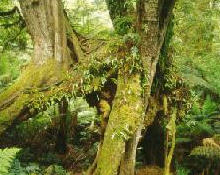Apollo Bay - Maits Rest Rainforest Walk and Glow Worms


Take the self-guided rainforest boardwalk at Maits Rest in the Otways and see beautiful fern gardens and giant rainforest trees up to 300 years old. Maits Rest is an easy walk located 17km to the west of Apollo Bay on The Great Ocean Road.
A wooden boardwalk has been built over the tree-fern gullies and moss-covered roots of ancient rainforest trees, protecting the delicate ecosystem while providing visitors with unique views of the forest.
The walk is named after Maitland Bryant one of the regions first foresters. The walk takes you through spectacular temporate rain forest. One of the biggest items of interest is the 300 year old Myrtle Beech tree, actually 2 or 3 trees combined. The tree is National Trust registered. At night look out for the glow worms along the soil banks beside the track.
Glow worms are actually bioluminescent i.e. glowing in the dark, maggots of a mosquito like fly. But whatever they really are, there's no denying that a walk through Glow Worm territory at night can be a magical sight.
Glow worms like wet and warm environments and the most likely time of the year to find them is during the warmer months of the year, between December to March but it is possible to see them most of the year although the display may be less impressive at these times.

Length: 800 metres
Walk: 30 minutes return
Track: Good
Grade: Gentle
Start: Maits Rest car park
Finish: Maits Rest car park
Getting There:
From Apollo Bay, follow the Great Ocean Road for 17 km and look out for the brown and white tourist signs. Mait's Rest will be on the left.
There are no picnic or toilet facilities. The closest are at Apollo Bay or the Aire River Camping area.
Places to See Glow Worms in the Otways
There are four places to see glow worms in the Otways. They are:
- Lake Elizabeth (near Forrest, 89km from Geelong)
- Kennett River (108km from Geelong)
- Melba Gully (near Lavers Hill, 135km from Geelong)
- Maits Rest (near Apollo Bay, 138km from Geelong)
Glow Worm Facts
Glow-Worms are not worms but rather the larvae of fly like insects called fungus gnats.
Tips on how to help protect Glow-Worms. As glow-worms prey on small insects, it is best not to wear insect repellent and to refrain from smoking or lighting fires in the 'Glow-Worm's' environment.
Larvae produce threads of sticky silk, their glow attracts prey which are then ensnared by the sticky threads.
The light "goes out" if disturbed in any way, For example: torch light or noise will turn out the light for up to 15 minutes.
Life Cycle. The adult Fungus Gnat lays up to eighty eggs, which hatch after 2-3 weeks. The larvae (Glow-Worms) grow over a period for up to nine months, they pupate for nine days after which the adult stage is reached. Only about 1.5 cm long in length, nocturnal, sluggish and harmless, the adult Fungus Gnat lives for only a short period (48 to 72 hours). When in flight they make a buzzing noise.
The adult fly has an uncontrollable light, with the female being brighter than the male until fertilised.
Where does the light come from? The end of the abdomen is luminous. The light is actually emitted from tiny tubes (malpighian tubules) which open into the gut of the larvae and are visible through transparent skin at the end of its body.
Glow-Worms are very shy! Please look, but don't touch. Glow-Worms are sensitive to disturbance and will 'switch off' their lights and retreat into a crack if they or their snares are touched.
Tips on how to help protect Glow-Worms. Glow-worms are nocturnal and rely on sunlight to set their daily rhythm. Shining torches on the insects signals them to 'switch off' their bioluminescence. To get the most out of a Glow-Worm display, make sure your torchlight is directed towards the ground.
Glow-Worms are found in dark damp places, often on soil banks with overhanging ledges.
Tips on how to help protect Glow-Worms. As well as residing in caves and under rocky overhangs, Glow-Worms can also be found along creek embankments and beside walking tracks. For this reason it is important to remain on designated walking tracks to prevent stepping on them.
Many thousands may live in large colonies, giving a spectacular effect.
Location
Great Ocean Road, Apollo Bay 3233 View Map









